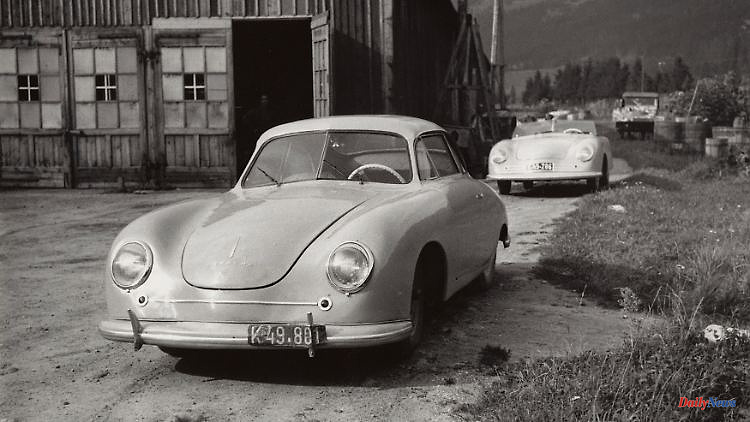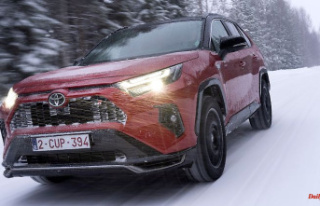Even with the first model, Porsche became a legend, a sports brand that rivaled the fastest Italians and Englishmen in terms of fascination. The Porsche 356 still carried the genes of the VW Beetle, but added a furious four-cylinder, seductive shapes and a low fighting weight.
He would have loved to have become a racing driver when he was young, but Ferry Porsche complied with the ban imposed by his father, the engineer Ferdinand Porsche, who was legendary at the latest for the construction of the Volkswagen Beetle and the Auto Union Silver Arrows. 75 years ago, Ferry's dream of having his own sports car with motorsport genes came true, realized in a barracks in Gmünd, Austria: that's where the Type 356 "No. 1" Roadster made its debut as the first Porsche ever built.
Even more, this racer with a mid-engine and tubular space frame, but otherwise only modified VW Beetle components, set the nucleus for the rise of Porsche to the highest-volume sports car brand in the world. The Porsche 356/2 Coupé and Cabriolet models were already being mass-produced in Gmünd from the winter of 1948/49, but now with a rear engine. The young company needed money for this start of series production, which is why Porsche sold the roadster with the famous chassis number 356-001 to the Swiss entrepreneur Rupprecht von Senger for CHF 7,000 on the day of registration. In fact, the sports machine with robust Beetle technology from Senger was so fascinating that in 1948 he placed an order for 50 Porsche 356s together with the Swiss car dealer Bernhard Blank.
Now the career of the Porsche 356 really got going, continuously accelerated by spectacular racing victories, production relocated to Stuttgart in 1950 and by ever faster variants such as the Speedster. Not only the 911, but the early 356 secured Porsche worldwide fame - as a brand that, like otherwise only Ferrari, can look back on a complete racing history.
Race wins are good for business, according to this credo, the No. 1 Porsche celebrated its press launch on July 4, 1948 in the vicinity of the Swiss Grand Prix in Bern - before it won its first circuit race a few days later in Innsbruck in front of a large audience. A VW boxer engine tuned to 26 kW/35 hp was enough for the 585-kilogram mid-engine roadster to beat much more powerful rivals.
After Innsbruck there was no holding back, there was hardly a classic that the Porsche 356 did not successfully contest: The 24 Hours of Le Mans as well as the Mille Miglia, Targa Florio or the Carrera Panamericana. And in Montlhéry, France, in 1951, Richard Frankenberg set the first long-distance world record for Porsche, but also for post-war Germany, with a 356 SL.
In 1952, Porsche was able to proudly point to 75 victories, 24 months later the result was an unbelievable 420 victories. In fact, the Porsche four-cylinder was a sensationally reliable driving machine, with which Porsche immediately broke into the phalanx of faster and often more dramatically shaped joy dispensers, most of which sported Alfa, Austin Healey, Jaguar or Triumph logos.
"Win on Sunday, sell on Monday", this marketing credo was followed by the sports car addict Americans even more than the Europeans - and the 3.87 meter small Porsche 356 was just right. In the fall of 1950, the former racing driver and successful New York car importer Maximilian Hofman took over the US sales of the Porsche sports car, which was advertised as the "German Automotive Jewel".
Whether in Watkins Glen or on racetracks in California, the expensive but nimble "Cars for Connoisseurs" with their small, air-cooled boxer units set new dynamic standards in the starting field for more powerful six and eight-cylinder engines.
Porsche became a cult in America, so it was not surprising that Hollywood stars and hobby racers such as James Dean and Steve McQueen also bought the 356 Speedster launched in 1954. Even in a muscle car cinema epic like "Bullit" a 356 Cabriolet could not be missing, and although blues idol Janis Joplin sang a hymn against consumption ("My friends all drive Porsches"), she owned a psychedelic painted one herself Porsche 356.
Originally, Ferry Porsche and his team hoped for a series of around 500 Porsche 356, in fact by the end of production in 1965 there were almost 78,000 examples of the rounded athletes. Erwin Komenda, who had already shaped the contours of the VW Beetle, was responsible for the design of the original 356. Above all, however, the Type 356 was a sports car according to Ferry Porsche's personal taste, as he once explained. A car that cost as much as two Volkswagen Beetles in 1950 and which therefore remained an eternal dream for most Germans even in the years of the economic miracle.
But Porsche managed the feat of anchoring the expensive 356 in society as an automotive figurehead. Not only the international sporting successes contributed to this, the more than 700 appearances of the Porsche 356 on cinema screens and in early TV programs were just as important. Not to forget the countless Porsche toy cars that conquered children's rooms or the fast Porsche 356 in police service.
"The car for today and the day after tomorrow" was an advertising slogan. To ensure that the 356 lived up to this claim, Porsche gave its first successful vehicle continuous technical and visual modifications. For example, the original 356 was recognizable by the two-part center disc, but from 1952 this was replaced by a one-piece disc. To the delight of the always performance-hungry Porsche fans, the Porsche with 1.1 liter four-cylinder was followed by a 160 km/h faster 1300 S, a 1.5 liter version - at that time the upper limit for important racing categories - and finally the 51 kW /70 hp 1500 S with a camshaft developed by the later company boss Ernst Fuhrmann.
In the autumn of 1955, the extensively further developed 356 A with panoramic windscreen replaced the original 356. 1.6-liter boxers were now also working under the rear hood, as the 1600 Super with a respectable 55 kW/75 hp, but the 1500 GS Carrera even cracked the then magical 100 hp mark. With so much power, the 356 Carrera catapulted itself into the small club of 200 km/h supercars.
On the other hand, the Cabriolet and Speedster with flat windscreens continued to cause a sensation as sun kings. But the Carrera B (1959-1963) and Carrera C (1963-1965) evolutionary stages also acted like a fountain of youth for the 356. This cult sports car therefore only reached the peak of its career when its successor, the 911 type, was already in the starting blocks.
The historical relevance of the Porsche 356 is explained by expert Frank Meißner from the classic car rating organization Classic Analytics: "The 356 can claim the title of Ur-Porsche, it was the first post-war German sports car and its legendary form is still alive today 911. In the meantime, it is more this form and less the sheer driving performance that makes classic car fans reach for the 356. The widespread and popular models include the 356C 1600SC Coupé, which today costs around 90,000 euros in good condition."
Chronicle
1938: On June 25, Stuttgart-Zuffenhausen becomes the headquarters of Porsche, and Porsche Plant 1 is later built there
1939: Ferry Porsche develops the first plans for a four-cylinder sports car under the Porsche brand even before the Second World War. They are implemented in the Porsche Type 64 or 60K10, which is to start in a planned Berlin-Rome race and is considered the forefather of later sports cars
1944: The air raids on Stuttgart lead to the relocation of the design office, which is busy with military orders, to Gmünd in Carinthia
1945: On August 8th, the Porsche factory in Gmünd receives an operating permit from the Allied military government for the development of civilian equipment such as tractors and motor vehicles. Ferdinand Porsche and Ferry Porsche are arrested by the Allies
1946: With the Porsche project number 352, Porsche designer Erwin Komenda designs a four-seater car for the Swiss customer Rupprecht von Senger, which looks similar to the later Porsche 356
1947: Gmünder Porsche KG develops a Grand Prix racing car on behalf of Cisitalia. On June 11th, the Porsche 356 "VW sports car" project with an air-cooled four-cylinder boxer engine starts at Porsche in Gmünd/Austria
1948: In March, Ferry Porsche undertook the first test drive with the 356, number 1. On July 11, Porsche employee Herbert Kaes achieved a class win in a road race in Innsbruck with the number 1. June 8th is considered the birthday of the production Porsche 356, because on that day the Carinthian state government issues an approval. Since Porsche needed money to be able to build more vehicles, Porsche sold the prototype to the Swiss entrepreneur Rupprecht von Senger for 7,000 Swiss francs on the same day as it was registered. The entrepreneur also accepts the next Porsche to sell in Switzerland. With the car dealer Bernhard Blank he prepares the future cooperation between Porsche and the Swiss company AMAG. The Porsche 356 goes into series production with a rear engine instead of the original mid-engine concept. The first Porsche 356 received the performance-enhanced four-cylinder boxer engine of the Volkswagen Beetle. The designer of the Beetle and the Porsche 356 is also identical: Erwin Komenda. In September, Ferry Porsche negotiated with VW General Director Heinrich Nordhoff that VW would henceforth pay a license fee of five marks per Beetle, that Porsche models could be sold through the VW sales network and that the Porsche engineers would grant VW developers consulting services for this
1949: The Dutch car dealer Ben Pon becomes the world's first official importer of Porsche models. Cooperation with the Stuttgart body work Reutter for the production of Porsche sports cars. The first 356 cabriolet, fitted with a body by the Swiss coachbuilder Beutler, was completed in February. Together with a 356 Coupé, Porsche is presenting the sports car at the Geneva Motor Show
1950: In the Gmünder-Porsche manufactory, production ends after 52 Porsche 356, plus the very first Porsche roadster. In March, production of the Porsche 356 begins in Zuffenhausen, which is offered at prices starting at 10,200 marks. The first official German Porsche dealer is Walter Glöckler from Frankfurt. At the Paris Motor Show in October, Ferdinand Porsche entered into a partnership with the North American sports car importer Maximilian E. Hoffman. The 356 from Stuttgart production has a body made of sheet steel. Ferdinand Porsche received such a coupé for his 75th birthday. After Porsche's death the following year, it covered around 400,000 kilometers as a test vehicle, under the name "Ferdinand". The test vehicle tested the first anti-roll bar and the first Carrera engine
1951: In order to conquer as many export markets as possible, Porsche presented the 356 at trade fairs and events in Brussels, Montlhéry, Frankfurt, London, Paris and Turin that year. Porsche established the customer magazine Christophorus, in the first issue of which Richard Frankenberg described the world record he had just achieved (10,987 kilometers with an average speed of 152.34 km/h) in Montlhéry with a Porsche 356 SL in the 1.5 liter class. It is the first record for Porsche and for Germany in the post-war period. Company founder Ferdinand Porsche dies on January 30. The 500th Porsche 356 is delivered in March. With the class victory of a Porsche 356 at the 24 Hours of Le Mans, Porsche attracted international attention
1952: Porsche designer Franz Xaver Reimspieß designs a trademark that celebrates its premiere as a coat of arms on the steering wheel hub of the Porsche 356. From 1954 the coat of arms can also be found on the front hood and from 1959 also on the hubcaps. In an edition of 15 units, the American Roadster for the USA is produced with an aluminum body by Gläser
1953: On October 1, the Porsche 550 celebrates its world premiere at the Paris Salon, which later shines in motorsport with the additional designation Spyder
1954: In September, the first 356 Speedsters are delivered for the US market
1955: Movie star and amateur racing driver James Dean buys a 550 Spyder after a 356 Speedster, with which he has a fatal accident. In October, production start of the revised Porsche 356 A with a 1.6-liter engine in the body styles Coupé, Cabriolet and Speedster. The sports versions 1500 GS and Carrera are new. Parallel to the Porsche 356 A, the Speedster, which has been in production since the previous year, remains in the range because the open-top sports car has many fans in the USA
1956: The Porsche 550 A Spyder wins the Targa Florio against superior-performing six- and eight-cylinder competitors. The 10,000th Porsche 356 is delivered at the same time as the company's 25th anniversary (the Porsche design office was founded in 1931).
1957: The Porsche 356 A Hardtop Cabriolet and 356 A Hardtop Speedster are new
1958: Porsche 356 A Cabriolet D replaces the 356 A Speedster. Also new is the 356 Convertible D and the 356 Hardtop with a fixed, non-removable roof. Richard von Frankenberg, racing driver and editor-in-chief of "Christophorus", owns the 356 "No.1" Roadster and trades it in for a 356 Speedster. Since then, Porsche has had the first vehicle ever built by the sports car brand
1959: After a total of 21,045 Porsche 356 A, the Porsche 356 B is launched as a coupé, cabriolet/hardtop and roadster. A total of 6,450 sports cars will be delivered this year
1960: The Porsche 356 hardtop from Karmann with a non-removable roof is new
1961: Porsche starts in Formula 1 with the four-cylinder 718/2 Monoposto and works driver Dan Gurney. Facelift for the Porsche 356 B (T 6)
1962: The 50,000. Porsche, an open 356 B, will be delivered on April 3rd
1963: In the middle of the year, the 356 C replaces the B model. Disc brakes are standard, there is an optional limited-slip differential, the choice of engines has been reduced to three aggregates and the body versions remain coupe and cabriolet. World premiere of the Porsche 901 with the new 130 hp six-cylinder boxer engine at the Frankfurt Motor Show. Porsche takes over the Reutter body shop
1964: On June 15, the Porsche management decides to supplement the top six-cylinder model, still known as the 901, with a four-cylinder version under the provisional type designation 902
1965: Presentation of the four-cylinder 912 in April. Prices start at 16,250 marks, while the Porsche 911 costs at least 21,900 marks. The Porsche 356 reaches the end of its production period
1966: On May 26, a last special series of ten Porsche 356 C Cabriolets rolls off the production line for the Dutch National Police. The actual production of the Porsche 356 had already been discontinued in the previous year. A total of 77,766 examples were built in Stuttgart
1998: The Porsche 356 turns 50 and Porsche celebrates the anniversary with an ad claiming that 70 percent of all Porsches ever built are still driving
2016: Singer Janis Joplin's psychedelic painted Porsche 356 SC sells for $1.76 million
2018: The Porsche 356 "No. 1" Roadster from 1948 is revitalized by Porsche as a show car in its original design, because the original has undergone many changes over time
2023: The Porsche 356 and with it the start of the sports car brand turns 75, an anniversary celebrated by Porsche and the fans












